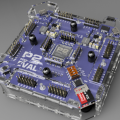Protecting a little PIC against over voltage with minimum parts
 W9GFO
Posts: 4,010
W9GFO
Posts: 4,010
The PIC has a voltage range of 2 - 5.5v with an absolute maximum rating of 6.5v. Maximum current through VDD or VSS is 80mA, through any one pin is 25mA.
One pin will be an input and one will be an output.
Would a 200 ohm resistor in series with VDD protect the chip against damage if it were supplied with 7 volts?
Rich H
▔▔▔▔▔▔▔▔▔▔▔▔▔▔▔▔▔▔▔▔▔▔▔▔
The Simple Servo Tester, a kit from Gadget Gangster.
One pin will be an input and one will be an output.
Would a 200 ohm resistor in series with VDD protect the chip against damage if it were supplied with 7 volts?
Rich H
▔▔▔▔▔▔▔▔▔▔▔▔▔▔▔▔▔▔▔▔▔▔▔▔
The Simple Servo Tester, a kit from Gadget Gangster.


Comments
A three-terminal 5V regulator plus two 'optional' input/output caps is nonetheless attractive,
because of the high-level of protection offered; but a pair of silicon diodes in series would be
easier and would probably do the job.
Would the 7V be an instantaneous transient or permanently applied? If just a transient, then
a beefy transzorb diode connected reverse-bias between VDD and VSS could be the answer.
Experience has taught me that a current-limiting resistor is a wise addition too, in case the
overvoltage is prolonged.
Regards,
T o n y
▔▔▔▔▔▔▔▔▔▔▔▔▔▔▔▔▔▔▔▔▔▔▔▔
Leon Heller
Amateur radio callsign: G1HSM
A regulator would triple the size of the board. It is very tiny, all SMD.
If VDD has a couple diodes ~1.0v drop, does that cause a problem for the input which may be 1v higher?
A 200 ohm resistor on VDD and a 1K on the input would limit the current to about 42ma going through the PIC. If that would not protect it - why not?
Rich H
▔▔▔▔▔▔▔▔▔▔▔▔▔▔▔▔▔▔▔▔▔▔▔▔
The Simple Servo Tester, a kit from Gadget Gangster.
▔▔▔▔▔▔▔▔▔▔▔▔▔▔▔▔▔▔▔▔▔▔▔▔
Leon Heller
Amateur radio callsign: G1HSM
If a chip has an ABSOLUTE maximum then don't even go close to it. However with regards to the supply voltage the biggest problem to put it in a simplistic nutshell is that the precarious isolation between "components" on the same silicon substrate usually consists of less than microscopically thin layers of "insulation" and "reversed biased" wells or junctions. So unlike most I/O pins etc even if you limit the current through the supply you can be upsetting the very foundation of the circuit, not just an I/O pin.
Looking at your reasoning though I am dumbfounded when you say adding a regulator would take up a lot more room. I use tiny SOT-23 pack LDO regulators all the time and they hardly take up any room. You can even forgo the input cap and just use a small 1uf on the output for this type of load.
▔▔▔▔▔▔▔▔▔▔▔▔▔▔▔▔▔▔▔▔▔▔▔▔
*Peter*
It was a guess but the space currently occupied by components is less than .04 in. sq. (.2" x .2").
I suppose I could use the other side of the board...
Rich H
▔▔▔▔▔▔▔▔▔▔▔▔▔▔▔▔▔▔▔▔▔▔▔▔
The Simple Servo Tester, a kit from Gadget Gangster.
▔▔▔▔▔▔▔▔▔▔▔▔▔▔▔▔▔▔▔▔▔▔▔▔
*Peter*